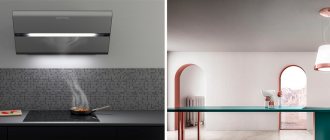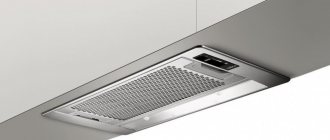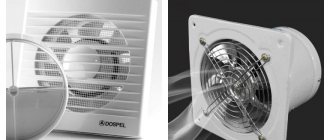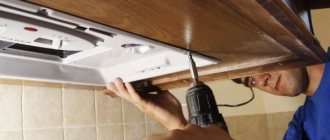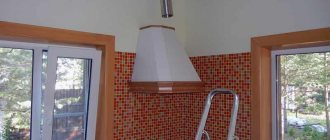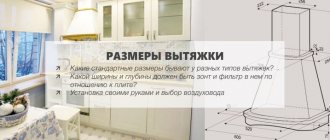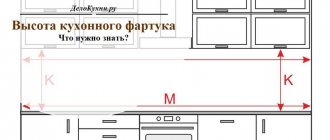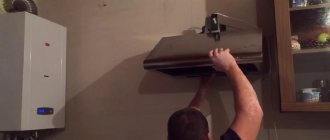For many housewives, a range hood is a must-have appliance in the kitchen. But it is not always possible to connect it to an air duct or simply take it outside. For such cases, there is an alternative - kitchen hoods without ventilation: they operate in air recirculation mode, which allows you to achieve freshness in a short time.
Question No. 1. Recirculation mode - what is it?
A conventional hood is a fan that sucks in air and sends it under pressure into the air duct or directly to the street. The recirculation unit is not connected to the air duct. We can say that it does not draw air under pressure, but is more like a fan with a filter that purifies the air. In this case, the air is not removed from the kitchen, but simply cleaned and released back into the air.
Recirculation is the name given to this process of ventilation, cleaning and re-introducing air into the kitchen. It turns out that the same air is “used” several times. This increases the humidity in the room, which can be critical for the kitchen.
A. Recirculation.
B. With a tap.
What to look for when choosing
The size should match the size of the hob or slightly larger. This determines how much air it can pass through the filters per unit time. Multiply the kitchen area by the height of the ceilings and by 12. You will find out the power of the hood - the unit of measurement is Cubic/hour. The resulting indicator is the lower limit of productive capacity. It is better if the figure is 30% higher.
Attention!
If the kitchen area is combined with a dining area, consider the total volume of the room. Find out in advance how many filters you need to install, their cost, and the availability of original filters and analogues in stores. You may encounter the problem of taking a specific model out of production, which means it will be difficult to purchase original filters.
Pay attention to the fan speed settings. There must be at least three of them. So, you can regulate the intensity of work and save energy. Many models are equipped with backlighting.
The electronic panel will show the operating mode, remind you of the need to replace the filter, automate the power switching mode, and help set up a schedule for turning on and off.
Question No. 2. What are they?
In general, recirculating hoods (without vent, carbon, filter) repeat the design of their colleagues with vent. There may also be additional functions such as backlighting or speed control. But the main difference between coal specimens without connection to ventilation is their placement:
- Hanging - a standard option that is mounted on the wall.
- Built-in - again attached to the wall, but the body hides in a closet.
- Island (stand-alone) - attached to the ceiling, suitable for a stove installed in an island.
The first two options are considered the most popular, so their model range is much wider than the others.
According to the type of housing they are divided into:
- horizontal fireplaces are the most familiar to the eye, where the working area of the hood is parallel to the working area of the stove;
- vertical - in such cases, the working areas of the stove and hood are perpendicular to each other. Unusual model with low performance - suitable only for large kitchens;
- inclined flat - the working area is at an angle to the stove. Looks impressive, works efficiently and silently, saves space;
- cassette (telescopic) - the working area of such models extends. After finishing work, it can be pushed in. Compactness is the main advantage.
Choosing the type of cabinet is not only based on personal preferences, but also based on the style of the kitchen. For example, no matter how popular inclined models are now, they will not fit into a classic interior.
There is also a classification based on the material from which the body is made.
| Metal (stainless steel, aluminum) | Suitable for use in high-tech, loft, and minimalist kitchens, as it will emphasize the modernity of the style. |
| Enamel | The most budget models, but the advantages are ease of maintenance. |
| Strained glass | A very beautiful piece of equipment that requires careful care and attention - it may not survive an accidental hit with a frying pan. |
Price
Prices for the simplest exhaust devices can start from 3.5 thousand rubles.
But on average, for a good quality unit you will need to pay 10-25 thousand rubles. Built-in hoods without an air duct are the cheapest - approx. 3.5 - 10 thousand rubles.
Example: Ukinox Compact 600.300.420 WH (Russian) mechanical control, 60 cm wide, 51 dB noise, power 420 m3/h, 2 speeds - 3600 rub.
Also reasonable prices for inclined models that look very modern. Example: Akpo WK-4 Nero eco 50 BK (Polish) mechanics, 50 cm wide, 52 dB noise, 420 m3/h, 3 speeds – 8000 rub.
Island models will cost the most because they have a unique design look. Prices for them start from 30 thousand rubles. and can exceed 100 - 120 thousand rubles. Example: Maunfeld Berta with transparent glass (English) - electronic control, 90 cm in width (glass diameter), 46 dB of noise, power 1050 m3/h, 3 speeds - 44 thousand rubles.
Carbon filters come in different shapes and sizes (selected according to the brand). The cost of the elements is 750 – 1000 rubles. If you come across a higher price, you need to look at how many pieces are included in the set - perhaps this is the wholesale price of several copies.
Question No. 4. What types of filters are there and how do they work?
In the standard set, the recirculation hood has two filters.
| Grease trap | It is through this filter that the air passes first. A metal (most often aluminum) shield with a fine mesh designed to trap large particles. Requires periodic cleaning, for example with regular dishwashing detergent. If heavily soiled, you can soak it. Metal is the most popular material for a grease filter, but in cheaper models you can also find other options, such as acrylic. |
| Coal (replaceable) | Charcoal can absorb odors, which is why it is used as a second filter. At the same stage, smaller particles are removed from the air. This filter cannot be cleaned, so it must be replaced. |
There are other filters, such as water filters. But they are used only in professional equipment in public eating places.
Types of hoods
Kitchens can have two types of ventilation: natural and forced. Each option is characterized by both positive and negative properties. We will not consider the external design; today there is a huge range of models. It is necessary to dwell only on the fundamental differences between the devices. Forced ventilation also has two types.
- Exhaust air without cleaning is supplied to vertical ventilation ducts. A flow hood removes air, the pressure in the kitchen decreases, fresh air enters through cracks in windows and doors or from special vents.
- The hood has special filters; air is forced through them and cleaned of grease, smoke, harmful chemical compounds and unpleasant odors. Clean air is again supplied to the room.
Flow and recirculation hoods
It is the second option that needs to be discussed in detail.
Find out how to install a kitchen hood with ventilation outlet yourself in a special article on our portal.
Question No. 5. How often do they need to be changed?
The anti-grease filter is not changed, but only cleaned as needed. Since it is in a visible place, it is easy to determine when cleaning is required - by the amount of dirt, dust and grease drops. It also depends on how often the hood is used.
Typically, the grease trap is wiped with a sponge and detergent once every 2-3 months.
To clean the filter from grease, you can also use folk remedies, for example, wash it with soda. To do this, apply soda to a damp sponge, wait until it softens a little, and then simply wash it.
There is a more modern option - wash it in the dishwasher.
Afterwards, the filter must be dried and inserted back. How to install it correctly in the hood can be found in the instructions. Usually this item does not raise questions or problems.
With a carbon filter the situation is more complicated. Even manufacturers give different wording in the instructions, for example:
- after a certain period (6–12 months);
- when the operation of the hood deteriorates (it begins to suck air worse, makes more noise, aromas do not disappear);
- according to the sensor readings - they are installed in the most expensive models and allow you to change the carbon filter just in time.
There are several factors that determine how long a carbon filter will last:
- on its quality - in more expensive models, the filters are of better quality and will last longer, while cheap ones can become dirty too quickly;
- how often, and what kind of food is prepared - if the diet consists only of fatty foods, then the filter will become dirty much faster. If only steamed cutlets are cooked 2-3 times a week, then replacement will not be needed soon.
It is difficult to name the average service life of a carbon filter. With frequent cooking of fatty foods, it can live for only a month. If cooking is not frequent and not aromatic, then this period can last up to a year.
How much does one such filter cost?
Its average cost is from 250 to 700 rubles. It turns out that it is more profitable to buy one good filter than to frequently change cheap ones.
Types of hoods without venting
If we compare two types of hoods - with and without ventilation outlets - then the first category has more advantages. The main advantage is higher performance, due to which air exchange occurs much faster.
Sometimes a number of technical issues prevent the installation of an exhaust device with a ventilation duct, and you have to buy a kitchen hood without an outlet and connection to the ventilation, that is, a recirculation one.
Based on the installation method, there are two types of hoods: separately installed and built-in. Built-in ones are good because they take up minimal space, and the cabinet in which the working unit is hidden is used additionally for its intended purpose - for storing kitchen utensils
Modern air purification devices differ in their materials, design, and technical capabilities.
Image gallery
Photo from
What are filter devices made of?
Various colors of hoods
Hoods for kitchen islands
Technical equipment of exhaust devices
The cost of devices directly depends on the technical “filling”, the quality of carbon and grease filter elements, design and level of the manufacturer. But you should choose carefully: sometimes models of popular brands are no different from little-known manufacturers, but cost 2-3 times more.
Question No. 6. Is it possible to make a carbon filter with your own hands?
Not everyone wants to spend money on expensive consumables, so the question arises what can replace them. Activated carbon from the nearest pharmacy costs a few rubles!
This option is only suitable for those filters that have real fractional carbon inside, and not a sponge or paper cloth soaked in it. In this case, the filter must be disassembled, the dirty coal must be pulled out and thrown away, and a new one must be filled in.
New coal, if it is in tablets, and not a special fractional one, it is advisable to crush it a little - the tablet can be divided into 3-4 parts.
You can do without new carbon: the second method is quite labor-intensive and is necessary only in cases where this carbon filter is no longer produced or it is impossible to find an analogue of the same diameter.
The filter must be disassembled, all the coal taken out and heated with a burner until red-hot, and allowed to cool. After this, assemble the structure back and install it in place. You can watch the video in more detail about the procedure itself, how to restore the filter and what it looks like before and after.
How to restore a kitchen hood's carbon filter.
Read more about extractor hood filters
Devices that operate without venting into the ventilation shaft are called coal devices due to the presence of carbon filters, which purify the air from specific kitchen odors. Most often these are plastic cassettes of various shapes and filled with activated carbon.
Sometimes pieces of synthetic material, also impregnated with activated carbon, are additionally used.
Round charcoal cartridges filled with granules or powder are usually sold and used in pairs. The plastic from which they are made does not change properties when heated and is safe for health.
In addition to the carbon filter, there is an anti-grease filter. For built-in models, it is located on the bottom panel and is a metal grille or mesh.
Of course, the mesh cannot catch odors, but it does an excellent job of removing particles of dissolved fat that rise with the steam. In this regard, it is recommended to wash the anti-grease filter approximately once every 30-40 days with non-abrasive agents.
Unlike the carbon filter, which is placed in the hood body along with the motor and fans, the metal grille is visible and is part of the design of the models.
When purchasing replacement products, please note that original and non-original (universal) filters are available for sale. The second group is suitable for many models and is lower in cost than parts produced by the manufacturer.
Carbon filters, as a rule, last for 3-4 months of active use, but the exact data is indicated in the instructions.
Question No. 7. What are the features of a recirculating hood?
It is important to know all the pros and cons that you can expect from a kitchen hood without corrugation. This information will allow you not to be disappointed in your choice in the future.
| Advantages | Flaws |
| You can hang equipment even where connection to an air duct or output to the street is impossible | Expensive filters need to be replaced. Sometimes these filters are also difficult to find |
| Cost savings, since hoods without outlets are cheaper than their “outlet” counterparts. In addition, there is no need to spend money on additional details such as air ducts, fastenings and decor to hide | Small selection of hood models without outlet |
| More compact size and neat appearance | Recirculating hoods are considered noisier, since their task is to “push” air through the carbon filter, and this requires power |
| If there is still a ventilation shaft, then it will not be occupied by the exhaust duct - air exchange will not be disrupted | Efficiency is not maximum - even the most expensive filters are not able to remove odor completely |
| Easy to install and install - no need to install an air duct | |
| Additional air flow is not needed even during long-term operation of the equipment | |
| No special care required, only filter replacement required |
Advantages and disadvantages
Decide what will be important to you at this stage. Analyze the budget that you are willing to allocate for equipment maintenance, how much time and effort you are willing to spend on its installation.
Advantages:
- cheaper than dome analogues and models with air vent;
- easy to install - they are built into the bottom of a box above the stove, which does not have a shelf, and are attached to the wall or ceiling;
- have standard installation dimensions;
- easy to clean - the filter can be replaced with a new one, and the body can be wiped with a furniture care product;
- do not require an additional source of fresh air;
- suitable for rooms of any layout and size;
- light in weight;
- emphasize the minimalism and practicality of a modern kitchen.
The disadvantage is the need to regularly change the filter, and a gradual decrease in operating power as the filter becomes dirty. Hoods with air venting require additional expense and effort at the installation stage, but its power remains constant and there is no need to purchase filters.
Attention!
If it is possible to install air exhaust, it is more profitable and efficient to install a hood with exhaust ventilation.
Question No. 8. For what cases is this ideal?
The main reason to install a recirculating hood is the inability to vent polluted air into the shaft or outside. There are several reasons for this:
- the mine is too far from the intended installation site of the hood, and there is no desire to build labyrinthine paths from corrugated paper;
- there is a shaft, but there are problems with the ventilation, for example, all the air with aromas gets to the neighbors;
- there is no shaft at all or there is no hole in the kitchen;
- the presence of reverse draft in ventilation (for example, when gas boilers or water heaters are installed) - the use of a standard hood here increases the risk of carbon monoxide poisoning;
- The air duct does not fit into the design.
The conclusion suggests itself is the following: a hood without an outlet should be chosen only if there is no possibility of making a hood with an outlet, since the latter is much more efficient and has a simpler operating mechanism.
Caring for your device
The hood is an indispensable assistant for every housewife in the kitchen. Because it absorbs all odors and harmful gas impurities during food preparation.
The device will last a long time if you regularly care for it: clean or replace the filter elements, as well as all other removable parts.
The operation is not difficult, but it can be a real challenge if fat deposits have accumulated over the years. In this regard, every housewife should know how to wash the product in any case.
Complete cleaning involves caring for the body, grille and all parts inside the appliance. Before you start cleaning, you should read the instructions in case the manufacturers have left any important recommendations when caring for the model. Disconnect from the power supply.
Then you need to carry out a number of preparatory procedures:
- Remove the hood cover and take out the filter element;
- Disconnect the supply pipe to the ventilation duct if the device has an air duct;
- Check the product body for contamination.
After the component parts of the product are removed, they must be washed in a cleaning agent. But when cleaning the grate, you may have to try different methods and cleaning agents.
Many methods have been found for getting rid of fat deposits on hoods, gas stoves and other equipment.
Folk remedies for washing off fat and scale:
- Soda. When treating with a soda solution, you need to pour water into a large container, add 3-5 tablespoons of soda, mix and boil the contaminated product in this solution for 20-25 minutes. Thus, the metal filter and grille are washed. If they do not fit into the container, then you can boil them from different sides. Then we take it out, dry it and put it back together in reverse order.
- Dishwashing liquid. It only removes small dirt, so we use it this way: you need to place the filter element in the solution for a few minutes, then scrub until completely clean, rinse with boiling water and dry.
- Acetic acid. This product is used when you need to clean the product from old stagnant dirt. To do this, you need to wipe all the fatty areas with a rag soaked in acid and clean off the dissolved fat after 10 minutes. Rinse parts with water and dry.
When working, you must take precautions: use rubber gloves.
Simple rules for caring for your exhaust hood
Question No. 9. How to install correctly?
As mentioned above, installation of a hood without outlet is very simple. There are just a couple of features to keep in mind:
- the height at which the hood will hang depends on the type of stove - if gas, then 75–85 cm, if electric, 65–75 cm;
- The hood itself is hung with bolts to the wall or ceiling, depending on the model.
That's all - no additional actions such as laying an air duct and covering it with decorative cabinets or installing grilles are required. To make sure you don’t miss anything, you can refer to the following step-by-step instructions:
- Check the strength of the base on which the equipment will be attached.
- Read the instructions and check the mounting kit that is required.
- Measure the distance from the hob to the bottom of the hood (the norm is indicated above).
- Check whether there is room for air to escape into the free space.
- Check the length of the wire and the presence of grounded outlets.
- Mark the locations of future fastenings.
- Install the fasteners using a drill or screwdriver.
- Hang the hood;
- Enable and check functionality.
This principle of operation is suitable for most models, but it is best to check the manufacturer's instructions for any installation or work specifications. The advantage is that the hood is easy not only to hang, but also to remove as soon as the need arises.
Recommendations for installation and operation
The hood can only be hung on a solid solid wall.
The technology for installing an electric hood without ventilation is very simple. But in order for the device to function correctly, you must strictly follow the instructions and prepare the installation site.
- The wall for mounting must be strong and level. It is prohibited to place the hood on a plasterboard structure.
- If the device is placed in a cabinet, it is advisable to strengthen the fastening of the latter.
- The height of the hood above the slab level is regulated by SNiP. The standards are as follows: 75 cm above a gas stove, 65 cm above an electric one.
- There should be a 220 V outlet near the hood.
- The device must be placed so that purified air flows freely out of the hood.
Valera
The voice of the construction guru
Ask a Question
Place the structure on brackets. Having drilled holes for dowels or screws, fix the brackets, and hang the hood on them in the desired position. After installation, you should immediately check the operation of the device.
Question No. 10. Is there two in one?
In fact, hoods are divided not only into two types (with and without vent). There is also a third - the most universal combined option - combining both of these modes. This technique can suck in air and discharge it into the ventilation or street, and in another mode, simply drive the air through a filter.
Such models appeared quite recently, but they are still not popular for two reasons:
- the price of such equipment is noticeably higher than analogues with one function;
- The recirculation mode is clearly inferior in efficiency to a conventional hood, so there is a chance you may even forget how to convert these modes - it will not be used.
It turns out that there is no point in a 2 in 1 hood, and there is no need to spend money on it.
Question No. 11. How to choose the best model?
There are several factors that need to be taken into account. Whether the owner will be disappointed in her purchase after a while or, conversely, will be happy, depends on how the hood looks externally and what characteristics it has. To achieve the second option, you need to try hard and pay attention to the following points.
Performance
Productivity is a measure that shows how effectively a certain job is done. In the case of a hood, this is to clean the air from third-party aromas. There is a special formula that will help determine the optimal performance for a specific kitchen.
You need to multiply the following values:
- ceiling height (for example, 2.5 m);
- length of the room (for example, 3.5 m);
- width of the room (for example, 3 m);
- coefficient 15.6.
This will result in optimal performance for a particular kitchen - this is the value you should focus on when choosing a hood.
You can get by with a simpler table.
| 200–300 m3/h | For a small kitchen where simple dishes are sometimes prepared |
| 300–400 m3/h | For an average kitchen or a family of 3-4 people who eat a varied diet |
| 500–600 m3/h | For large families who love to eat delicious food and experiment with cuisine |
Dimensions
The dimensions of the hood should depend on the stove over which it is located. The rule is this: the hood has the same dimensions (length and width) or larger. In no case should it be less, since the effect of the technology in this case will tend to zero.
It is advisable to select a slightly larger slab: either in width or in length. The best option is when the hood is 10 centimeters wider than the slab - then 5 cm remain on each side. The advantage in length is also acceptable, but it is not so comfortable when cooking - there is a risk of hitting the dome with your head.
Standard hood width: 50, 60, 70 cm.
Noise level
It’s not very good if the neighbors think that instead of a new hood you bought an airplane that flies around the apartment several times a week. The noise can also disturb the owners of the equipment themselves, especially if there are small children or not the bravest animals.
To make cooking comfortable even with the hood on, you should look for equipment with a noise level of 50–55 dB. The quietest models operate at a level of 35–42 dB.
It is worth noting that cost is not an indicator of noiselessness, and perhaps even the opposite: expensive models are the most powerful, which means they can produce a lot of noise. It is better to focus on the number of decibels.
Additional functions
Additional functions of the hood can also make the housewife’s life easier:
- timer is a convenient function for those cases when the dish itself is also prepared using a timer, for example, in an oven or multicooker. The timer will allow you to set up the operation of equipment according to a schedule;
- the ability to change speeds is a useful function that will help regulate the hood power depending on the degree of air pollution;
- The electronic display is a small detail that will make working with the hood much more convenient. You can immediately see the mode in which the equipment operates, and also, if something happens, an error code will appear, which will help you save a lot of money on repairs;
- indicators - we are talking about indicating the degree of contamination of the carbon filter. Such a system will allow it to be changed in a timely manner, which means that the efficiency of the hood will not decrease;
- built-in sensors - the most advanced models have sensors that themselves determine the degree of air pollution around them. If necessary, they turn on or off independently;
- remote control - controlling the hood using a remote control is especially convenient in the kitchen-living room or in the studio.
As an additional function, you can also select a flashlight, but at the moment it is found in almost all hoods - even the most inexpensive ones.
Brand
It is also important to pay attention to the manufacturer’s brand, since this is to some extent a guarantee of quality. It is known that some budget brands skimp on technology and materials, so their customers do not leave service centers. But there are also time-tested brands that do not skimp on quality.
| Ariston | The best-selling brand of household appliances in Russia. Assembled in Italy, which is reflected in the ideal style and even beauty, without sacrificing quality. |
| Bosch | The range of hoods is very wide and varies in design and cost. Most often assembled in Germany, so it is initially considered more reliable. |
| Gorenje | Gorenje has long specialized in filter hoods, so it can boast of impeccable quality. The perfect balance of functionality and resource consumption. Made in Slovenia. |
| Electrolux | This Swedish manufacturer is worth contacting if you want the latest technologies, innovations and unusual features. Simple and comfortable control is another hallmark of Electrolux equipment. |
| Zigmund-Stain | If an unusual and bright design is important, then you should pay attention to this German brand. The quality is comparable to the mentioned competitors. |
Hoods from famous brands
Due to their engineering features, recirculating types of hoods do not belong to the category of very complex products; therefore, many companies are engaged in their production. But not all of them treat consumers responsibly and do not pay due attention to the quality of materials and technological processes.
Which companies meet current consumer demands?
Table. Popular models of hoods
| Name of recirculation hood | Description and brief operating characteristics |
| Low noise hood, has effective sound insulation of the mechanical compartment and the most modern sealed bearings. Touch electronic control, fan power 800 m3/hour, which is quite enough even for large kitchens. There are three main speeds of operation; in addition, you can turn on perimeter or intensive suction. LED backlight increases the attractiveness of the device, the noise level is no more than 60 dB. The disadvantages include the lack of a carbon filter. |
| A very original appearance can decorate not only kitchens; such hoods can be installed in work rooms if its owner and guests have not given up the bad habit of smoking. Designers recommend using units in modern studio kitchens. Electronically controlled hood, width 100 cm, capacity 550 cubic meters. meters. The electric motor with an extended operating hours has three speeds and an intensive mode. This mode is used to quickly clean the air in case of critical smoke pollution. An advantageous advantage is the presence of a filter contamination indicator, which simplifies its timely cleaning or replacement and increases the operating time of the unit. Disadvantage - the noise level is 75 dB, which is quite high for residential premises. |
| The hood resembles an ordinary pendant lighting fixture, and therefore can be installed in any room. It has two filters, which improves the quality of air purification. Touch control system, four operating speeds, there is a remote control. The design is improved due to halogen lighting; the fan power is 550 m3/h. Disadvantages - the carbon filter clogs relatively often; untimely replacement has a negative impact on the duration of operation, the quality of air purification and operating noise. |
| The very compact hood barely attracts attention and successfully imitates a modern lamp with LED bulbs. An air pollution control indicator tells owners when to turn on the device. The control is electronic, there is a remote control. With a capacity of up to 830 cubic meters of air per hour, the hood occupies a leading position among household units in terms of this parameter. Using a timer, automatic on/off settings can be made; there are three operating speeds and an intensive air purification mode. A noise level of 66 dB fits within the tolerance range for this type of household appliance. Disadvantages: high cost and lack of a carbon filter. |
| Built into suspended and suspended ceilings, the enclosed space further reduces operating noise. The engine power is only 220 W, which makes it possible to reduce energy losses and reduce financial costs. Height 19 cm, productivity 830 m3/h, there are three operating speeds. If you need to quickly clean the air, the intensive mode is activated. Automation allows users to configure the optimal interval mode of on/off. There is an option for air suction around the perimeter of the device, the noise level is no more than 50 dB - one of the lowest values among all types of household hoods. The disadvantage is the high cost and the lack of a carbon filter. |
| An original hood built under the countertop. The fan capacity is 960 m3/h, has four operating speeds and touch control type. Duplicated by a portable remote control. The maximum noise level does not exceed 66 dB; two filters are installed to capture grease and unpleasant odors. Disadvantage: the very high cost significantly reduces the number of potential consumers. |
Of course, these are not all models and manufacturers of hoods; the table shows only brands with world-class quality. Buy products from well-known companies; this approach will allow you to avoid many troubles.
Rules for installing a recirculation hood
Prices for the range of kitchen hoods
Hoods
Question No. 12. How to properly care?
Caring for the hood is not difficult. All that is required is to periodically inspect the equipment and filters for contamination. If there are appropriate sensors, then the work becomes exactly half as much, since the indicator itself will tell you when it is necessary to replace the carbon filter. However, you should familiarize yourself with the following rules:
- Avoid abrasives and strong chemicals.
- Disconnect the device from the mains during cleaning and during long trips.
- Carefully remove filters so as not to damage small parts.
- Selection of identical filters - otherwise the level of air purification will drop significantly.
- Glass surfaces are treated with glass cleaning products.
These are basic recommendations that will suit most instances. The best solution would be to read its instructions for use before using the equipment for the first time - this action will answer many questions that arise.
How to choose a hood for a kitchen without an air duct
Let's look at the features and parameters that need to be taken into account.
Power
The performance (or power) will determine how easily and quickly the device can clean the air. For the system to be truly effective, it must pass through the entire volume of the room 6 to 12 times per hour.
Based on this, the power is calculated:
- Find the area of the kitchen (length multiplied by width).
- The volume is calculated (area multiplied by height).
- The resulting value is multiplied by 6, 7, 8... or 12.
For example, if the area = 9 m2 and the ceilings are 2.8 m.
The volume of the room will be 9 x 2.8 = 25.2 m3.
The weakest hood that can be purchased: 25.2 x 6 = 151.2 m3/h
Optimal option: 25.2 x 12 = 302.4 m3/h.
Filter
There are two types of filters installed in hoods:
- Carbonic.
- Fat absorbing.
Carbon is a very effective adsorbent for odors based on activated carbon. Requires replacement when soiled (on average after 2-6 months).
Grease absorbent traps dirt from the air.
This also protects the internal parts of the hood from them.
There are three types:
- Metal.
- Acrylic.
- Non-woven or paper.
Metal ones consist of layers of aluminum. It is worth buying filters that have 5 or more layers, otherwise they are simply not effective. This aluminum mesh can be washed in the dishwasher (separate from the dishes) and used again.
Acrylic filters can also be washed in warm soapy water.
Paper is a one-time filter option. There is text on its surface. As soon as it cannot be distinguished, the element is discarded.
It is important to change filter devices on time not only because the productivity of the hood decreases, but also because oil and grease accumulated on the grate can ignite during cooking.
Noise level
Circulating hoods in ductless kitchens create a sound that can be annoying. It is necessary to take into account that the larger the unit in size, the more noise it will make. You can specifically look for models of small sizes.
The technical data sheet must indicate the sound level. There are models with a reduced rate. A level of up to 40 - 42 dB is considered acceptable.
Design
Let's look at the types of hoods for kitchens without an air duct. Hoods are available in five variations in shape:
- Dome (classic bulky look).
- Inclined (outwardly similar to an LCD TV, take up little space).
- Island (do not have a back wall, hinged, can be round).
- T-shaped (another type of attachment, but with a flat bottom surface on which the control panel can be placed).
- Built-in (after mounting into kitchen furniture, only the bottom plane of the device remains visible).
Dome hood in the kitchen interior
Other options
You also need to consider:
- Unit size (the width of the installation is measured if the device will be placed between cabinets).
- What type of control - mechanical or electronic.
- Availability of backlight.
- It is convenient if there is a built-in timer or clock.
- Is there a filter change indicator?
- Is there a control panel?
Results
A hood without a pipe is an excellent solution when it is not possible to connect equipment to ventilation. Yes, compared to standard models, it will work only 70%, but it has a lot of other advantages such as price, compactness and the ability to install anywhere in the kitchen, even in a cabinet or above the island. It is only because of the last property that designers fell in love with it so much. In order not to make a mistake with your choice, you need to approach it carefully, but this will pay off in the future with proper work and fresh air in the kitchen.
Did you like the article? Tell your friends about it:
4 1 2
Supply valves
The need to use valves is caused by the complete tightness of modern window structures, which prevents the penetration of street air into the house through the gaps between the frame and the frame, as happened previously with ordinary wooden windows. Even if in a small volume, there was still an influx. The entrance doors, which did not have several sealing contours, as they do today, cracks under the window sills and other “leaks” also contributed. Of course, you can let fresh air into the house by setting the tilt-and-turn window sash to ventilation mode, but do not forget that you will have to do this constantly - both in winter and summer, regardless of the weather. Just like through an open window, rain moisture, dust and noise easily penetrate into the resulting gap (sound insulation is reduced by almost half) and blow noticeably, and in winter a cold zone appears around the perimeter of the sash and ice may even appear on the frame. In addition, when there is a gust of wind, the window “whistles” and slams strongly, loosening the hinges and creating serious acoustic discomfort. One more nuance: a window with slot ventilation is a real gift for a burglar.
All these problems can be solved by equipping windows with ventilation valves. Models of different brands differ in performance, installation method, type of control and adjustment capabilities.
An example of such devices is the REHAU AEROVENT+ ventilation valves, which are three slotted holes made with a milling cutter in the upper part of the rebate and closed on both sides with covers.
The slots can have different sizes, and the total length of the valves ranges from 275 to 700 mm. The outer cover is equipped with a mosquito net and a self-regulating damper curtain: it covers the channels in the event of strong wind pressure or large thermal differences, thereby limiting excess inflow. The inner cover is designed to direct the stream of outside air upward, under the ceiling. There it quickly mixes with the warm air of the room, acquires a comfortable room temperature and replaces the exhaust air completely imperceptibly for humans - without “icy blows” and drafts. The valve operates on natural draft, without requiring user participation in the process, and it can be equipped with a window with any profile thickness, not only at the manufacturing stage, but also when it is already installed in the opening.
The slot holes in the vestibule are covered with a special lid
The REHAU AEROVENT+ cover has an acoustic foam insert
To determine the maximum performance of the valve, a pressure difference of 10 Pa is used: for AEROVENT+ this figure is 30 m³/h, which is the sanitary standard for fresh air supply per person
When equipping a window with a ventilation valve, the temperature in the room decreases by no more than 1–2⁰С. Its influence on the soundproofing properties of the structure is also minimal: the noise level increases by only 1–2 dBA, to which the human ear is immune. , an acoustic foam insert can be placed in the device cover
which will serve as an additional barrier to noise.
REHAU has developed GLASSOVENT valves (AR75) especially for large houses. They are designed to ventilate several rooms at once (maximum length of products is 2.5 m) and reach a productivity of 113 m³/h per linear meter of device. The model provides both manual and electric control and a four-stage adjustment system. The valve is located between the end of the glass unit and the sash profile, so in the case of a previously installed window, the unit will need to be replaced. The equipment of the devices includes hollow (heat-insulated) dampers, as well as highly efficient electrostatic fine filters Pollux.
Since with the installation of a ventilation valve it is no longer necessary to open and close the shutters many times a day, the load on the fittings and seals is removed, which eliminates the need for frequent window adjustments and ultimately significantly extends its service life
Design of a wall supply valve
Instead of window valves, you can use wall valves, and in rooms without windows (pantry, dressing room) they are generally the only option.
The devices are a tube with a diameter of 40 to 160 mm and a length of 200 to 1000 mm, at the outer end of which there is a protective grille or cap, and at the inner end there is a compact block with a valve mechanism. They are mounted in a through hole in the wall in the window area (if there is one), the main thing is that the supply stream quickly mixes with the warm air rising from the radiator. There are valves that require installation under the window sill or directly behind the heating radiator. The products are equipped with heat and sound insulating liners, filters, temperature and humidity sensors with automatic adjustment of flow intensity.
Valve Vents TwinFresh RA-50-2, price 9040 rub.
Valve Blauberg Fresher 50, price 15,000 rub.
Vents 102 valve with solar battery, price RUB 5,400.
Sill valve
Another option for supply valves is window sill valves.
The products are about 400 mm wide and are installed directly behind the edge of the window sill above the radiator. The air intake duct runs under the window structure and is covered from the outside by ebb, so that when viewed from the street the device does not reveal itself in any way. The valves do not reduce the soundproofing properties of the window, do not violate its integrity and do not require making holes in the walls. The products are heat and sound insulated, equipped with a filter and allow you to regulate the volume of incoming air by smoothly moving the damper.
